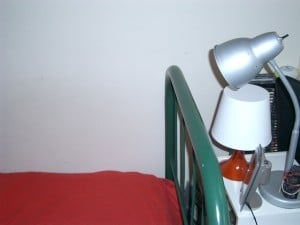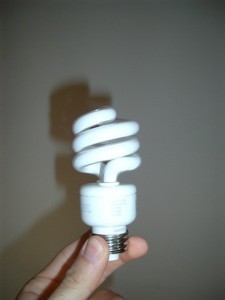We’ve all grown immune to our alarm clocks. I’ve gone through several alarm clocks because I’ve grown immune to each one. I could continue to buy a new alarm clock every few months, disturbing my roommates every time I hit the snooze button.
I’ve decided a few months ago to change up my tactics, not my alarm clocks to combat blaring sirens only my roommates hear, and skipping showers so I’m not late to work every morning.
Our bodies were designed to wake up at first light with the sun which doesn’t do much good in a dark room – no matter how loud the alarm clock is. I’ve seen sunrise alarm clocks advertise in various places, but those can be expensive ($100), especially on a college budget.
So I decided to build my own, and here’s how you can tool for less that $25.
1. The first thing that you’ll need is a cheap lamp. Any lamp will do, just make sure that it has an adjustable neck so it can hang over your bed. Kinda like the sun, get it?

2. You need to get a low-watt light bulb, something less than 60W. I recommend getting a halogen lamp. Although a standard lamp will do, halogens burn for much much longer (and better for the environment too :)).

3. Go to any general purpose store and buy yourself a light timer – they are cheap and will allow you to set what time to wake up.

4. Set the green pin 15-20 minutes before you’d like to wake up. More if you’re like me and a deep sleeper, less if you are like a rabbit drinking coffee.
5. Set the red pin a good 30 minutes or so after you are planning on waking up, in case you have trouble one morning, that constant warm glow of your sunrise alarm clock will make sure you get out of bed.
6. Now you’re all set! You can begin waking up with your eyes, not your ears. The best thing is, your roommates won’t be bothered by it. It is silent, and not nearly bright enough, even for most spouses in the same bed.
Some tips to keep in mind
- Test out your new sunrise clock on the weekend to make sure it works. Or if you prefer sleeping in, set it a bit earlier than normal during the week to make sure you are adjusted to your clock.
- Run the time 360 degrees once around to make sure the light flicks on and off.
- Remember to take the light bulb out on the weekends to avoid being awaken at 6am on a Saturday!
- Remember to put the bulb back in on Sunday!
- Alternate the use of a quite sound alarm clock to keep your brain on it’s toes, and for those mornings after a late night.
Good luck, and enjoy!












you are a genius… i HAAAAAAAAAAATE alarm clocks… so i take it this sun clock works?
works like a charm, i’ve been using one for the past 6 weeks and haven’t woken up late since
I’ve been trying to work out how to make one of these. I don’t understand what a light timer is, though sorry. Is it just an electronic timer that you plug in, or is it specifically for lights? Ideally, it would be something that comes on GRADUALLY, coming on over 30 minutes like the shop bought sunrise alarm clocks do. Thanks.
@ Phil:
Sorry for the poor wording, the setup is rather simple. I just use any regular outlet timer – unfortunately I couldn’t find a good one that allows for gradual illumination (but let me know if you find one 😉
What you could do (a bit more complex setup), is have 3 lights – and place one at the opposite end of your bedroom, one by your bed, and the other one right above your head…and set each one to come on 5-10 minutes apart from farthest to closest.
Hope this helps, let me know how it works out!
I have an alternative, but you have to be happy with getting up with the sun! (and it costs about $50, but still less than half the price of a commercial sunrise clock!)
My bedroom gets zero sunlight due to the orientation of my house. So I bought one of these:
http://www.jaycar.com.au/productView.asp?ID=AA0346&keywords=dimmer&form=KEYWORD
and one of these:
http://www.jaycar.com.au/productView.asp?ID=RD3480&keywords=ldr&form=KEYWORD
I soldered the LDR in series with the dimmer pot (keep this for some sensitivity adjustment), and on the output side of the dimmer wired up a 4-way powerboard. Then you just plug in up to 600W (240v) of lamps, and stick the LDR out the window or on the roof.
I also bought a mains wall timer, so the circuit would only be active from 5am, otherwise bright full-moons might light up the lamps.
Works a charm, but only good if you want to wake up with the birds!
Coffeegeek
Pretty cool setup – I’m a morning person so I don’t mind getting up with the sun (even if it is artificial).
Anil,
Why is it that I cannot see the pictures in this post?
Ah, sorry about that. I think it’s due to the fact I change image galleries some time ago and some of the older posts were affected. I can track down the pictures and repost if you’re interested, just let me know and I’ll see if I can find them.
Hi! Please repost the pictures; I’m interested in trying this. Thanks!
Hope this helps, not the best I know but this post is old!
Thank you so much! This does help. Now I’ll know exactly what I need to buy. Thank you.
I wonder if a cheap compact flourescent bulb would get you the gradual effect. We bought some that take five minutes or so to come to full brightness. Not good for the dining room, but they would work well for this application.
It would help, especially with lower wattage bulbs I’d assume.
Here is a cost effective alternative solution for the light bulb. Try one of the earliest generations of those energy efficient light bulbs. One day an apartment manager was complaining about how they start very dim and I told her about a silver lining I discovered. This is the perfect light to wake up to in the dark. It starts dim, and gradually gets bright. Its 2 in the morn, you turn it on and you’re not blinded. Have to wake up at 5am, and your eyes have time to adjust. Fortunately I saved 5 of these early on. My brother introduced me to this, it was impractical for everyday use at that time, but was a cheap alt to the Day Light light.
Interesting, do they still sell them?
That’s a good question. Kind of doubt it. After all there is new and “better” technology. The newer tech of curse needs improvement. Such as being able to work in enclosed light fixtures, being able to dim (as of this writing this might have been taken care of, there is something like diode as apposed to fluorescent). The bulbs I referred to in previous post might have come out in mid 1990’s. The bulb I have is a GE compax (trademarked name) FLB15/TL. Made in Japan. This bulb is 15w 120v 60hz. Other markings will be LAMPHOLDER FITTING E-76227. The number I just listed is below text Lmph… and below numbr is the text LISTEC 99CB (go2Botom4BeterOrganizaton Of Info).
Here is a visual description. Wish I had camera. The glass or plastic enclosure on top is like one of those tall glass domes that you might place over some figurine (hope that makes sense). This is attached to a funnel shaped devise that tapers down to a traditional light bulb screw devise for a lamp. The bulb is 6.5” tall and about 3” wide.
When these bulbs the general reaction was that the light was horrible, they started very dim, and the light was not the best for reading. I liked it because it did not blind you in the morning, and gradually brightened. It was and is a low consumption light which I keep on for long periods for general low level lighting, and I had other lights which I used for specific task. This kind up bulb you don’t want to turn on and off a lot because it will shorten the life span. The manufacturers probably figure there is not enough interest, but if enough people became interested that could change. (Marketing)
GE compax (trademarked name)
FLB15/TL
Made in Japan
15w 120v 60hz
LAMPHOLDER FITTING
E-76227
LISTED 99C8
Thanks for the detailed info Alan!
I set one of these up myself before finding this post. I thought about using a blue bulb, commonly known as a “daylight bulb” which is about $5 or so, apparently it’s the closest thing to natural daylight.
They’re a good alternative and also have long-lasting varieties.